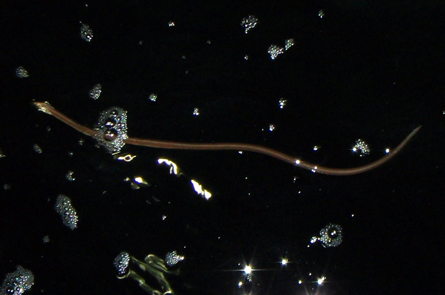Eels point to suffocating Gulf floor
Stench of rotten eggs reinforces concern
In June, scientists predicted that the Gulf of Mexico’s annual dead zone — a subsea region where the water contains too little oxygen to support life — might develop into the biggest ever. In fact, that didn’t happen. Owing to the fortuitous arrival of stormy weather, this year’s dead zone peaked at about 6,800 square miles, scientists reported on Aug. 1 — big but far from the record behemoth of 9,500 square miles that had been mentioned as distinctly possible.


That’s the good news. The bad: Substantial portions of the affected Gulf weren’t just low in oxygen, but virtually devoid of it from the surface to the seafloor. And researchers could literally smell the problem, notes Nancy Rabalais, executive director of the Louisiana Universities Marine Consortium, based in Chauvin. Where oxygen loss occurs at the seafloor, she reports, the sediment gurgles up hydrogen sulfide — a gas that carries the stench of rotten eggs to the surface.
Nor was this the only sign of a very perturbed environment.
As in past years, Rabalais and her colleagues spent time at sea this summer mapping oxygen levels (see below) at various depths across the northern Gulf. In July, Rabalais witnessed foot-long eels swimming at the surface. Normally they live in the Gulf sediment. Some seafloor-dwelling crabs also propelled themselves dozens of feet up to the surface to avoid suffocating.
“I have seen brown shrimp (not on this cruise) doing the same thing. They live in the mud as well,” she says. And for them to swim up 65 feet to avoid the suffocating bottom waters was an act of desperation, she says, because they would have been prime fish food all along the way.
Such sights attest to the severity of oxygen depletion, or hypoxia, that developed in some regions of this year’s dead zone’s waters. As oxygen concentrations at the seafloor approach zero, the chemistry at this sediment-water interface shifts, releasing hydrogen sulfide. This poses a double whammy to aquatic life, Rabalais explains: Not only is there little or no oxygen present, but hydrogen sulfide can itself kill organisms that can’t swim away.
Even those that can move may develop subtle reproductive toxicity, Rabalais adds, pointing to work by Peter Thomas of the University of Texas at Austin’s Marine Science Institute in Port Aransas.
His team has studied croakers, a type of fish that can find itself living in oxygen-depleted waters. Initially, his team reported an absence of spawning — because affected croakers lacked mature eggs or sperm. More recently, Rabalais notes, his team “has showed that the low oxygen has led to some sex change in croakers that live in the area — turning females into males.”
Links to farm runoff
Dead zones require two predisposing factors: a surfeit of nutrients and a stratification of the water into two stable, unmixing zones. The Mississippi River is responsible for both, Rabalais explains.
Its spring delivery of fresh water, which is less dense than brine, can lead to that stratification of water. The river also deposits fertilizer — principally nitrate — that feeds the growth of algae and phytoplankton. As these organisms die, their bodies drop into the lower zone and decompose. But the microbes responsible for that degradation use up oxygen that, owing to the segregated layering of waters by salinity levels, will not easily become replenished. This leads to a growing loss of oxygen at depth. If the situation progresses long enough, oxygen depletion can climb up the water column, virtually to the surface.
The excessive upper Midwest flooding this spring and summer fueled the Gulf with fresh water and nitrogen, which is why a monster dead zone had been anticipated. But along came Don, a tropical storm, in late July (it made landfall in Texas on the 29th). Its churning action whisked oxygen-rich surface waters into the suffocating depths, curbing the growth and ultimate size of this year’s dead zone, Rabalais says.
But that was just a matter of luck, she adds. And quite fortunate as well, because evidence is building to indicate “the Gulf is becoming less resilient to nitrogen pollution,” she observes. Over time, it’s taken smaller inputs of nitrogen to create large low-oxygen areas. And “that’s definitely not good news,” she says.






